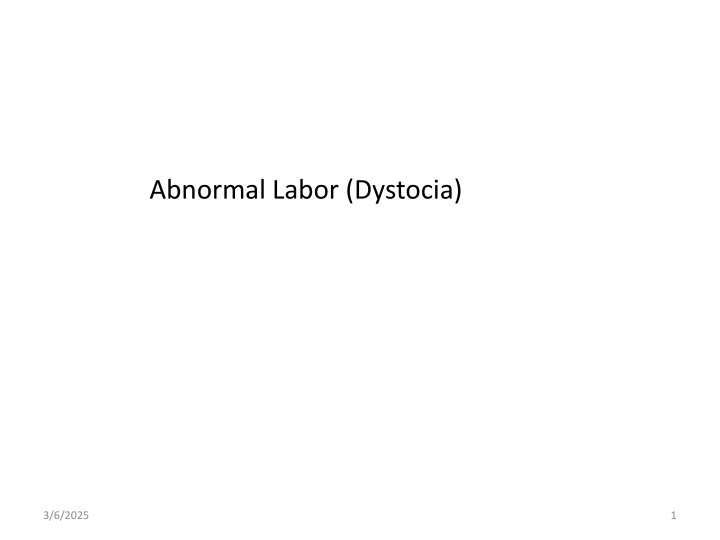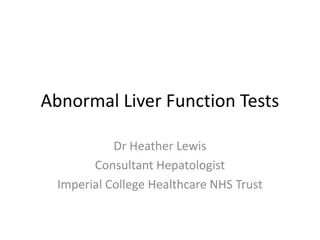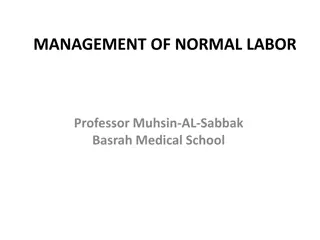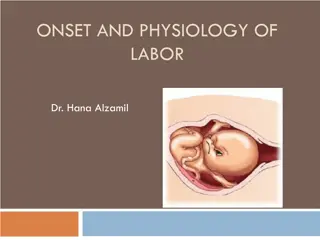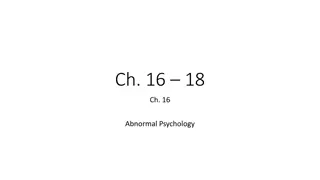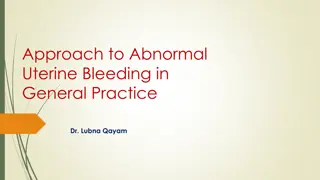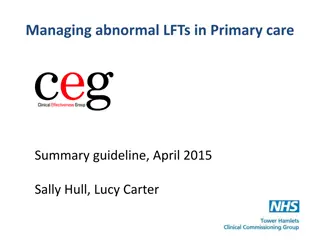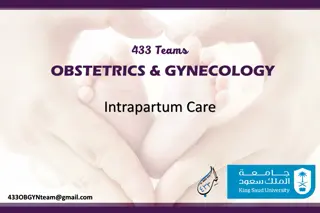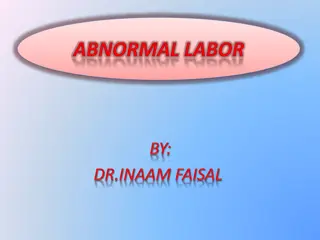Abnormal Labor: Definition, Classifications, and Management
An overview of abnormal labor (dystocia) including its definition, classifications, and management options. Learn about the patterns, etiologies, diagnosis, and management of abnormal labor. Explore the challenges in diagnosing and addressing abnormal labor patterns such as prolongation, protraction, arrest disorders, and precipitate labor.
Download Presentation

Please find below an Image/Link to download the presentation.
The content on the website is provided AS IS for your information and personal use only. It may not be sold, licensed, or shared on other websites without obtaining consent from the author.If you encounter any issues during the download, it is possible that the publisher has removed the file from their server.
You are allowed to download the files provided on this website for personal or commercial use, subject to the condition that they are used lawfully. All files are the property of their respective owners.
The content on the website is provided AS IS for your information and personal use only. It may not be sold, licensed, or shared on other websites without obtaining consent from the author.
E N D
Presentation Transcript
Abnormal Labor (Dystocia) 3/6/2025 1
Outline Definition of abnormal labor (dystocia) Classifications of abnormal labor patterns Etiologies of abnormal labor Diagnosis of abnormal labor Management options of abnormal labor patterns 3/6/2025 2
Learning objectives At the end of this sections the students will be able to: Define abnormal labor (dystocia) know abnormal labor patterns Describe Etiologies of abnormal labor in each pattern Diagnosis abnormal labor Know management options of abnormal labor patterns 3/6/2025 3
Definition of Abnormal labor An abnormal labor is any labor in which the pattern of labor progress is significantly different from accepted and recognized patterns of labor progress in terms of cervical changes, decent of fetal presenting part or profile of uterine contractions. Dystocia interchangeably to denote an abnormal labor pattern ( difficult labor) is often used 3/6/2025 4
Classifications of abnormal labor patterns Four major groups Prolongation disorders Protraction disorders Arrest disorders Precipitate labor 3/6/2025 5
Prolongation Disorders Prolonged latent phase of labor A latent phase lasting longer than 20 hours for nulliparas and 14 hours or longer for multiparas or more than 8 hrs in partograph labor management protocol. Challenge in diagnosis is often due to the problem in diagnosing the exact time of onset of labor 3/6/2025 6
Protraction Disorders Two protraction disorders Protracted cervical dilatation A cervical dilatation less than 1.2 cms in the multigravida and 1.5 cms in the primigravida during active labor Protracted descent Descent of the fetal presentation less than 1 cms per hour in the multigravida and 2 cms per hour in the primigravida 3/6/2025 7
Arrest Disorders arrest disorders Arrest of Cervical Dilatation No cervical dilatation for 2 or more hours in the active phase of labor Arrest of descent No descent for more than 2 hours Two precipitate labor disorders Precipitated dilatation Precipitated descent 3/6/2025 8
Etiologies of abnormal labor related to one of the four P s of labor determinants Abnormalities of the powers Primary power uterine contraction Secondary power maternal expulsive efforts Abnormalities of the passages Contraction of the bony pelvis inlet, midpelvic , outlet Soft tissue dystocia tumor previa, vaginal septa etc Abnormalities of the passenger Psychological factors Often due to stress of labor affecting autonomic nervous system 3/6/2025 9
Abnormalities of the powers Ux dysfunction (dystocia) is the most common cause of protraction or arrest disorders in the first stage of labor Any abnormality in the force or coordination of Ux contractility that prevents the normal progress of labor 3/6/2025 10
Bony abnormality (Pelvic dystocia) Any contraction of the pelvic diameter that diminishes the capacity of the pelvis can create Dystocia during labor. Contracted pelvic inlet AP< 10cm (N 10cm) or if greatest transverse is <12cm(N=13.5cm) usually defined as DC <11.5 cm Dystocia more common when both diameters are contracted than only one is contracted prior to labor fetal BPD average 9.5 to 9.8cm difficult for some fetus to pass through inlet with AP <10 cm. 3/6/2025 11
3/6/2025 12
Contracted mid pelvis Interspinous <8cm (N = 10.5cm) More common than inlet contraction No precise manual method of measuring mid pelvic dimension but convergent pelvic side wall , narrow sacrosciatic notch suggest contraction Contracted outlet interischial tuberous < 8cm Rare without concomitant midplane contraction Causes perineal tears b/se of perineal distension prominent spine, 3/6/2025 13
Abnormalities of the passenger (fetus) leading to dystocia Fetal macrosomia Multifetal gestation Congenital anomalies e.g. hydrocephalus Malpresentations/malpositions 3/6/2025 14
Diagnosis of abnormal labor patterns - Steps Document following parameters against time Uterine contraction profile Cervical dilatation/effacement Descent of fetal presentation Compare against normal patterns for respective parity, identify any deviations and then classify into respective abnormal patterns Look for specific etiology responsible for the abnormal labor patterns by carefully assessing the four determinants of labor progress (P s of labor) 3/6/2025 15
Evaluation for causes of abnormal labor patterns Assessment of the four P s of labor Assessment of powers of labor three ways Palpation of uterine contractions External tocodynamometer Intrauterine pressure catheter monitoring Maternal exhaustion, vital signs, blood glucose and evidence of dehydration Assessment of the passenger Size, number, presentation, position and anomalies of the fetus by Leopold's palpations and ultrasonography Assessment of the passages Bony pelvis clinical pelvimetry Soft tissue dystocia vaginal exam Assessment of maternal emotional status and pain control 3/6/2025 16
Management of abnormal labor depends on specific etiology diagnosed Power abnormalities Uterine inertia Augmentation Secondary powers failure Instrumental assistance Passenger abnormalities Often caesarean deliveries required Destructive deliveries in cases of fetal deaths Abnormalities of the passages Often Caesarean delivery Episiotomy for perineal level obstruction 3/6/2025 17
Specific labor abnormalities Disorders of the Latent Phase Prolonged latent phase- Expectant management is most appropriate. Augmentation -of labor if expeditious delivery is indicated Therapeutic rest-if contractions are painful, with an analgesic agent such as morphine. - alleviate painful contractions and allow the patient to rest comfortably until active labor begins. 3/6/2025 18
Specific labor . Active phase disorders Protracted active phase(slower than normal progress) Cervical dilatation < 1.2 cm/hr primipara and < 1.5 cm/hr multipara < 1cm/hr cervical dilatation for a minimum of 4hrs (WHO) Causes -CPD in adequate ux contraction Arrest of dilatation(complete cessation of progress) can be diagnosed when the cervix ceases to dilate after reaching four or more cm dilatation for two or more hours -no dilatation for > 2hr (at least 4 hrs) Cause- in adequate ux contraction (80%) -CPD 3/6/2025 19
Management of active phase disorders . Oxytocin to achieve three to five contractions every 10 minutes, or contractions every 2 to 3 minutes . Amniotomy should be performed if rupture of membranes has not already occurred, before entertaining the diagnosis of failure to progress. 3/6/2025 20
Thank you 3/6/2025 21
